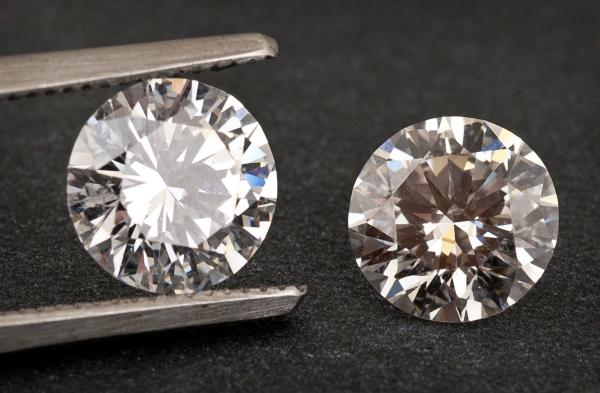Have you ever heard the term lab-grown diamonds? These diamonds are becoming super popular, especially among younger engaged couples. The stones are totally real—they’re just man-made!
So, what does that mean and why should couples be interested in a lab-grown diamond versus a natural diamond? We’ll break down the differences between the two, plus the benefits of purchasing this new type of diamond.
What are the differences (& similarities) between natural & lab-grown diamonds?

Courtesy: mygemologist.com
The two biggest differences between a lab-grown and natural diamond are the origin and the price. One diamond comes from the earth and is more expensive; the other diamond comes from a lab and is less expensive. No matter how where they come from, both types are considered to be real diamonds. Here are some more similarities and differences between the two.
Similarities:
- Both types of diamonds have the same physical properties, chemical composition & crystalized structures.
- Both types also exhibit the same fire, scintillation & sparkle.
- These two types of diamonds are nearly impossible to differentiate from the naked eye. Only through testing with specialized equipment can you spot the differences.
- Both vary in color, clarity & cut.
- Both types are evaluated & graded under the same strict standards by independent gemological labs.
Differences:
- Natural diamonds are taken straight from the earth through mining. Lab-grown diamonds require no mining and are formed in a controlled environment through high temperatures & pressures.
- Natural diamonds take billions of years to develop while lab-grown diamonds take a few weeks to develop.
- Lab-grown diamonds may have different trace elements, but it doesn’t affect the appearance.
- Natural diamonds produce three times fewer carbon emissions per carat.
- The cost of a lab-grown diamond is about 30-40% less than a natural diamond.
Want to put your vision to the test? Check out this video of lab-grown and natural diamonds side by side:
Why is there a significant price difference between lab-grown & natural diamonds?
Here’s a simple way to put it: a lab-created diamond touches fewer hands, making it less expensive. It takes significantly less energy to create a diamond than to go through the long process of mining a diamond.
This is great news for couples looking to save money because a lab-grown diamond will ultimately cost you less, but it still looks like a natural diamond. A mined diamond costs between $2,500 to $16,000 per carat—so that’s hundreds or thousands of dollars you could save. That means more money in your pocket for your honeymoon or money towards a house.
Since lab-grown diamonds are still fairly new to the market, experts don’t know what the pricing or resale value (like most gemstones) will be like years from now. Just something to keep in mind for the future.

Courtesy: brilliantearth.com
So, which is the better option: lab-grown or natural diamonds?
Overall, lab-grown diamonds are better for the environment, ethically sourced, use less energy to create and are much cheaper in price. On the flip side, many couples love the science and history behind natural diamonds. Also, the natural diamond industry supports the livelihood of nearly 10-million people worldwide including diamond producers and employees. Ultimately, the decision is between you and your spouse and what you value.

